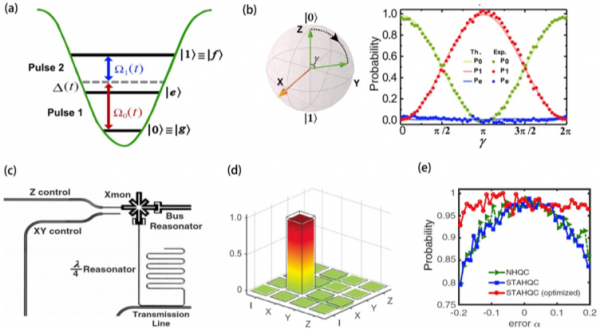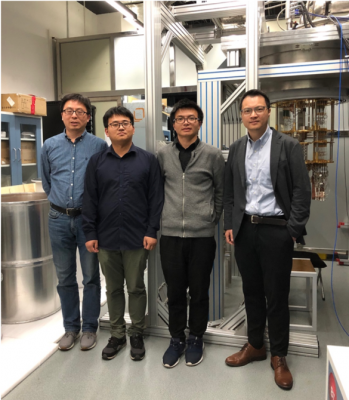Research on quantum computation is at the very frontier of today’s science and technology. It explores revolutionary ways of information processing using quantum resources such as quantum entanglement and superposition. Its potential applications are expected to have a profound impact on our society. In principle, any controllable quantum system can be used to implement quantum computation. However, quantum systems easily lose their quantumness due to their ubiquitous interaction with the environment, making the construction of a quantum computer extremely challenging.
Recently, a team led by Man-Hong Yung (associate professor) and Yuanzhen Chen (assistant professor) from the SUSTech Institute for Quantum Science and Technology and the Department of Physics has made progress towards the realization of quantum computation based on superconducting quantum circuits. The result was published in the journal of Physical Review Letters titled “Experimental Realization of Nonadiabatic Shortcut to non-Abelian Geometric Gates.”
Among the various proposed ways of implementing quantum computation, the one using superconducting quantum circuits is widely considered as one of the most promising routes. On the one hand, superconducting quantum circuits can be readily designed and fabricated using techniques of today’s microelectronics. On the other hand, these quantum circuits are usually controlled by off-the-shelf microwave electronics, unlike many other quantum systems where sophisticated and dedicated control techniques must be developed.
At the most basic level, one of the most common implementations of quantum computation relies on the decomposition of quantum algorithms into a series of specific quantum gate operations. For such an implementation, a core task is therefore to develop quantum logic gates of high fidelity. In this regard, the team at SUSTech proposed and experimentally demonstrated a new scheme of single-qubit quantum logic gates based on geometric quantum phases using superconducting quantum circuits.
The fundamental construction blocks of building a quantum computer are quantum bits or qubits. They can be realized on any two-level quantum system whose two states are used to encode 0 and 1, respectively. Single-qubit quantum logic gates can be considered as controlled evolutions of a qubit. During such evolutions, the two quantum states of the two-level system usually obtain different quantum phases. The difference between these phases can be precisely controlled by carefully adjusting parameters of the external driving signals, and quantum logic gates can be constructed from such phase differences.

In general, there are two types of phases resulting from quantum evolutions, termed as dynamical and geometric phases, and therefore corresponding dynamical and geometric quantum gates. It is believed that geometric phases are usually more robust against ambient noise, so it should be easier to achieve high fidelity on geometric quantum gates. However, generating geometric phases usually requires the adiabatic condition to be fulfilled in that the corresponding quantum evolutions must be slow enough.
The reduced speed results in a much longer operation time for geometric quantum gates, compared to dynamical quantum gates. The longer operation time is undesirable since qubits always have finite decoherence time. Decoherence time is essentially the lifetime of qubits while they maintain their quantumness. The lifetime of qubits can be reduced by their interaction with the environment. The SUSTech team overcame this problem by using a technique called shortcut-to-adiabaticity to accelerate the geometric quantum gates in their proposal.
Prof. Man-Hong Yung, together with graduate student Bao-Jie Liu, proposed a scheme employing a three-level quantum system. The ground and the second excited states of the system are used to form a qubit, whereas the first excited state is an auxiliary state. By applying two microwave pulses that are slightly off-resonant with the two quantum transitions of the system, and precisely designing the shape of the two pulses, researchers can accurately generate any desired geometric phases and realize arbitrary geometric quantum gates.
Prof. Yuanzhen Chen, together with postdoctoral researcher Tongxing Yan, successfully demonstrated this proposal on superconducting quantum circuits and achieved a fidelity of 97% for single-qubit quantum gates. These gates are several times faster than most conventional geometric quantum gates and exhibit a better fault tolerance about errors in the control pulses. The significant contributions to the infidelity include decoherence caused by the interaction between the qubit and the environment and errors in the microwave control signals.

The work of the SUSTech team may inspire further interest in some regions of geometric quantum computation. The team is now pursuing the realization of two-qubit quantum gates following the same idea of shortcut-to-adiabaticity, as well as even more straightforward ways of implementing geometric quantum computation.
The experimental part of the work was assisted by Prof. Haohua Wang’s group at the Zhejiang University and Prof. Xiaobo Zhu’s group at the University of Science and Technology of China (USTC). Tongxing Yan and Bao-Jie Liu were the first authors of the paper. Man-Hong Yung and Yuanzhen Chen were the corresponding authors. Dapeng Yu, a Chaired Professor of the Department of Physics of SUSTech and the Director of the SUSTech Institute for Quantum Science and Engineering, was the last author.
This work was supported by the National Natural Science Foundation of China, the Natural Science Foundation of Guangdong Province, the Guangdong Innovative and Entrepreneurial Research Team Program, and the Shenzhen Municipal Science and Technology Innovation Commission.
Original article: https://journals.aps.org/prl/abstract/10.1103/PhysRevLett.122.080501
Proofread ByChris Edwards
Photo ByInstitute of Quantum Science and Engineering